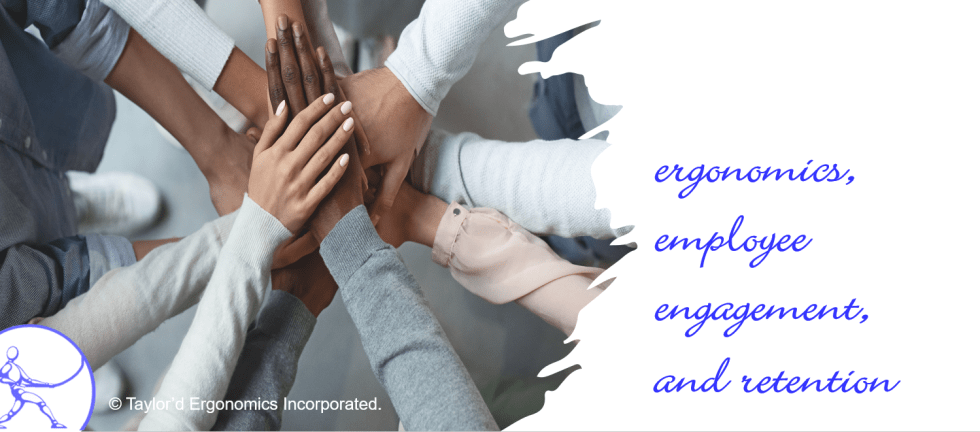Attracting and retaining talent has become more challenging in the past three years. It’s an employee’s market out there. During “The Great Resignation”, in the face of the pandemic’s doom and gloom, we had more time to think about what really matters to us, and many people considered career changes. Many (though not all) of us were surprised at how much we valued the convenience of working from home.
As an employer, I’ve thought a lot about how to attract the best ergonomists to our team. If you google-search “preferred employer”, you’ll find many tips, some of which actually include ergonomics. They might refer to “benefits like ergonomic equipment”. For employees working from home, ensuring that they are supported with furniture and the skills to adjust it, can make all the difference in the world. This is true even for ergonomists; we’re in the process of setting up our own home office furniture purchase program. (You might think that most ergonomists would already have an “ergonomic” home office, but in truth, most of us didn’t expect to be spending time working from home!) In workplaces with more physically demanding work, the effect of ergonomics should be even more obvious; if your job requires contorting your body all day, wouldn’t your thoughts be consumed with finding a more comfortable job? Perhaps prospective employees won’t know exactly what type of work they are applying for, but most of them will ask around, and look online to get more information about the nature of the work and the employer’s work environment. The take-home message here: An employer who offers an ergonomic workplace is more attractive to jobseekers.
Employee engagement refers to how committed current employees are to the company. If you’re interested in employee engagement surveys, 20 Employee Engagement Questions for Your Next Survey (indeed.com) is a link to an article with some great questions. In particular, think about the financial implications of this one: “Do you plan to work here one year from now?” If even 10% of respondents say “No”, what does that mean for your recruitment and training budget?
Another key to retaining talent is to operate the business in accordance with the corporate mission and vision. If you, as a company, say that you value employee input, then, when employees tell you they are uncomfortable, you ought to listen! As I’ve discussed before (Ergonomics, via productivity and quality | LinkedIn), an organization’s vision statement and branding will tell prospects a lot about how they might be treated as employees. You might attract great talent with a lofty vision, but you won’t keep them if your actions don’t align with your vision.
How does ergonomics really fit into all of this?
If you’re interested about learning to identify and measure employee engagement benefits, join us on November 18 in Cambridge. Click here to register. Or contact us for consulting help at info@taylordergo.com.
Here are some very specific ways that we help our clients to build better engagement using ergonomics:
- Employee ergonomics awareness campaigns. We’ve been generating awareness content for almost 20 years. That means that we’ve created over 100 monthly bulletins, over 400 weekly ergo thoughts, and more than 35 ergo contests. We cover topics that are directly applicable to work (safe lifting, early recognition of signs and symptoms, heat stress prevention) as well as ergonomics at home and leisure. We’ve built a library of resources so we can respond to virtually any “question”.
- Buying new office furniture, vehicles, or equipment for the plant? Select equipment that will accommodate even your smallest and tallest workers. Roll the implementation out with training that will ensure that people will be successful in using it, ergonomically.
- Our employee ergo training involves “hands-on” activities so participants get to experience the effects of ergonomics first-hand. Invariably, there are some “ah-hah” moments where people realize that these tips will really make a difference in the workplace.
- Ergonomics (MSD risk) assessments require an ergonomist to listen to employee concerns and consider them when developing recommendations. They often involve surveys so we can hear from employees on all shifts. Everyone has a say.
- When an employee has a specific issue with a job upon return from an injury, providing one-on-one job coaching can be very effective. Sometimes, the employee is learning to adapt to a new limitation, and sometimes they are also adapting to a new job. An ergonomist can help to find ways to do the job without aggravating discomfort.
- The principles of engagement apply to both labour and management. HR and Safety people need to be supported with the documentation they need to facilitate successful accommodations after an employee illness or accident. Supervisors need help from ergonomists to make the changes that will protect workers from injury.
A quote from a client we’ve worked with since 1995:
“Taylor’d Ergonomics helps keep a safe work environment for all our employees. It keeps our employees engaged. Employees see that the company is putting forth their best efforts to ensure their health and safety, which increases employee morale.”
A quote from a client we’ve worked with since 2018:
“Sharing best practices on how to do the job with the least effort and still accomplishing the task has been a huge accomplishment. We are working smarter, not harder. Our employees appreciate this immensely….Having an onsite resource is a welcomed support for an HSE professional.”


